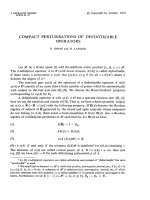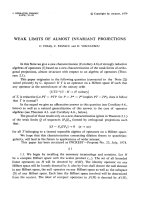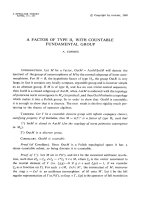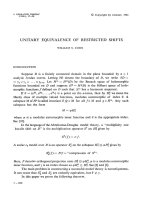Báo cáo toán học: "Linear Discrepancy of Basic Totally Unimodular Matrices" pptx
Bạn đang xem bản rút gọn của tài liệu. Xem và tải ngay bản đầy đủ của tài liệu tại đây (101.79 KB, 4 trang )
Linear Discrepancy of Basic Totally Unimodular
Matrices
Benjamin Doerr
∗
Mathematisches Seminar II, Christian–Albrechts–Universit¨at zu Kiel
Ludewig–Meyn–Str. 4
24098 Kiel, Germany
Submitted: April 6, 2000; Accepted: September 13, 2000
AMS Subject Classification: Primary 11K38
Abstract
We show that the linear discrepancy of a basic totally unimodular matrix
A ∈ R
m×n
is at most 1 −
1
n+1
. This extends a result of Peng and Yan.
AMS Subject Classification: Primary 11K38.
1 Introduction and Results
In [PY00] Peng and Yan investigate the linear discrepancy of strongly unimodular 0, 1
matrices. One part of their work is devoted to the case of basic strongly unimodular
0, 1 matrices, i. e. strongly unimodular 0, 1 matrices which have at most two non-
zeros in each row. The name ’basic’ is justified by a decomposition lemma for strongly
unimodular matrices due to Crama, Loebl and Poljak [CLP92].
A matrix A is called totally unimodular if the determinant of each square submatrix is
−1, 0 or 1. In particular, A is a −1, 0, 1 matrix. A is strongly unimodular, if it is totally
unimodular and if this also holds for any matrix obtained by replacing a single non-zero
∗
supported by the graduate school ‘Effiziente Algorithmen und Multiskalenmethoden’, Deutsche
Forschungsgemeinschaft
the electronic journal of combinatorics 7 (2000), #R48 2
entry of A with 0. Note that for matrices having at most two non-zeros per row both
notions coincide.
The linear discrepancy of an m × n matrix A is defined by
lindisc(A):= max
p∈[0,1]
n
min
χ∈{0,1}
n
A(p − χ)
∞
.
Theobjectiveofthisnoteistoshow
Theorem. Let A be a totally unimodular m×n matrix which has at most two non-zeros
per row. Then
lindisc(A) ≤ 1 −
1
n+1
.
Our motivation is two-fold: Firstly, we extend the result in [PY00] to arbitrary totally
unimodular matrices having at most two non-zeros per row. We thus expand the as-
sumption to include matrices with entries of −1, 0, and 1. This enlarges the class of
matrices for which Spencer’s conjecture lindisc(A) ≤ 1−
1
n+1
herdisc(A)isproven
1
. Sec-
ondly, our proof is shorter and seems to give more insight in the matter. For the problem
of rounding an [0, 1] vector p to an integer one we provide a natural solution: We par-
tition the weights p
i
,fori ∈ [n]:={1, ,n}, into ’extreme’ ones close to 0 or 1 and
’moderate’ ones. The extreme ones will be rounded to the closest integer. The moderate
ones are rounded in a balanced fashion using the fact that totally unimodular matrices
have hereditary discrepancy at most 1. The latter is restated as following result:
Theorem (Ghouila-Houri [Gho62]). A is totally unimodular if and only if each sub-
set J ⊆ [n] of the columns can be partitioned into two classes J
1
and J
2
such that for
each row i ∈ [m] we have |
j∈J
1
a
ij
−
j∈J
2
a
ij
|≤1.
This approach is a main difference to the proof [PY00], where the theorem of Ghouila-
Houri is applied to the set of all columns only.
2 The Proof
Let p ∈ [0, 1]
n
. Without loss of generality we may assume p ∈ [0, 1[
n
(if p
i
= 1 for some
i ∈ [n], simply put χ
i
= 1). For notational convenience let P := {p
j
|j ∈ [n]} denote the
set of weights. For a subset S ⊆ [0, 1] write J(S):={j ∈ [n]|p
j
∈ S}.
1
We will not use this notion in the following explicitly, but an interested reader might like to have
this background information: The discrepancy disc(A):=min
χ∈{−1,1}
n
Aχ
∞
of a matrix A describes
how well its columns can be partitioned into two classes such that all row are split in a balanced way.
The hereditary discrepancy herdisc(A)ofA is simply the maximum discrepancy of its submatrices.
the electronic journal of combinatorics 7 (2000), #R48 3
For k ∈ [n +1] setA
k
:=
k−1
n+1
,
k
n+1
.Fork ∈
n+1
2
set B
k
:= A
k
∪ A
n+2−k
.Fromthe
pigeon hole principle we conclude that there is a k ∈
n+1
2
such that |P ∩ B
k
|≤1or
n +1isoddand P ∩ A
n
2
+1
= P ∩
1
2
−
1
2(n+1)
,
1
2
+
1
2(n+1)
= ∅. The latter case is solved
by simple rounding, i. e. for χ ∈{0, 1}
n
defined by χ
j
= 0 if and only if p
j
≤
1
2
we have
A(p − χ)
∞
≤ 1 −
1
n+1
.
Hence let us assume that there is a k ∈
n+1
2
such that |P ∩ B
k
|≤1. By symmetry
we may assume that P ∩ A
k
= ∅ (and thus P ∩ A
n+2−k
may contain a single weight).
Set X
0
:= J(
0,
k−1
n+1
)=J(A
1
∪ ∪ A
k−1
), the set of columns with weight close to 0,
M := J(
k
n+1
,
n+2−k−1
n+1
)=J(A
k+1
∪ ∪ A
n+1−k
), the set of columns with moderate
weights, M
0
:= J(A
n+2−k
) containing the one exceptional column, if it exists, and finally
X
1
:= J(
n+2−k
n+1
, 1
)=J(A
n+3−k
∪ ∪ A
n+1
), the set of columns with weight close to
1. Note that [n]=X
0
˙
∪M
˙
∪M
0
˙
∪X
1
.
As A is totally unimodular and has at most two non-zeros per row, by Ghouila-Houri’s
theorem there is a χ
∈{0, 1}
M∪M
0
such that the following holds: For each row i ∈ [m]
having two non-zeros a
ij
1
,a
ij
2
,(j
1
= j
2
), in the columns of M ∪ M
0
we have χ
j
1
= χ
j
2
if and only if a
ij
1
= a
ij
2
. Eventually replacing χ
by 1 − χ
we may assume χ
j
=1
for all (which is at most one) j ∈ M
0
. As any two weights of p
|M∪M
0
have their sum in
2
n+1
, 2 −
1
n+1
and their difference in
−
n
n+1
,
n
n+1
, we conclude |
j∈M ∪M
0
a
ij
(p
j
−χ
j
)|≤
1 −
1
n+1
for all rows i that have two non-zeros in M ∪ M
0
.
Let χ ∈{0, 1}
n
such that χ
j
=0,ifj ∈ X
0
, χ
|M∪M
0
= χ
and χ
j
=1,ifj ∈ X
1
.This
just means that the extreme weights close to 0 or 1 are rounded to the next integer, and
the moderate ones are treated in the manner of χ
. Note that an exceptional column is
treated both as extreme and moderate.
We thus have
(∗) |p
j
− χ
j
|≤
k−1
n+1
x ∈ X
0
∪ X
1
k
n+1
if x ∈ M
0
1 −
k
n+1
if x ∈ M
.
Let us call a row with index i ’good’ if |(A(p − χ))
i
|≤1 −
1
n+1
.Thenby(∗)allrows
having just one non-zero are good, as well as those rows having two non-zeros at least
one thereof in X
0
∪ X
1
. Rows having two non-zeros in M ∪ M
0
were already shown to
be good by construction of χ
. All rows being good just means A(p − χ)
∞
≤ 1 −
1
n+1
.
This ends the proof.
References
[CLP92] Y. Crama, M. Loebl, and S. Poljak. A decomposition of strongly unimodular
the electronic journal of combinatorics 7 (2000), #R48 4
matrices into incidence matrices of digraphs. Disc. Math., 102:143–147, 1992.
[Gho62] A. Ghouila-Houri. Caract´erisation des Matrices Totalement Unimodulaires.
C. R. Acad. Sci. Paris, 254:1192–1194, 1962.
[PY00] H. Peng and C. H. Yan. On the discrepancy of strongly unimodular matrices.
Discrete Mathematics, 219:223–233, 2000.









